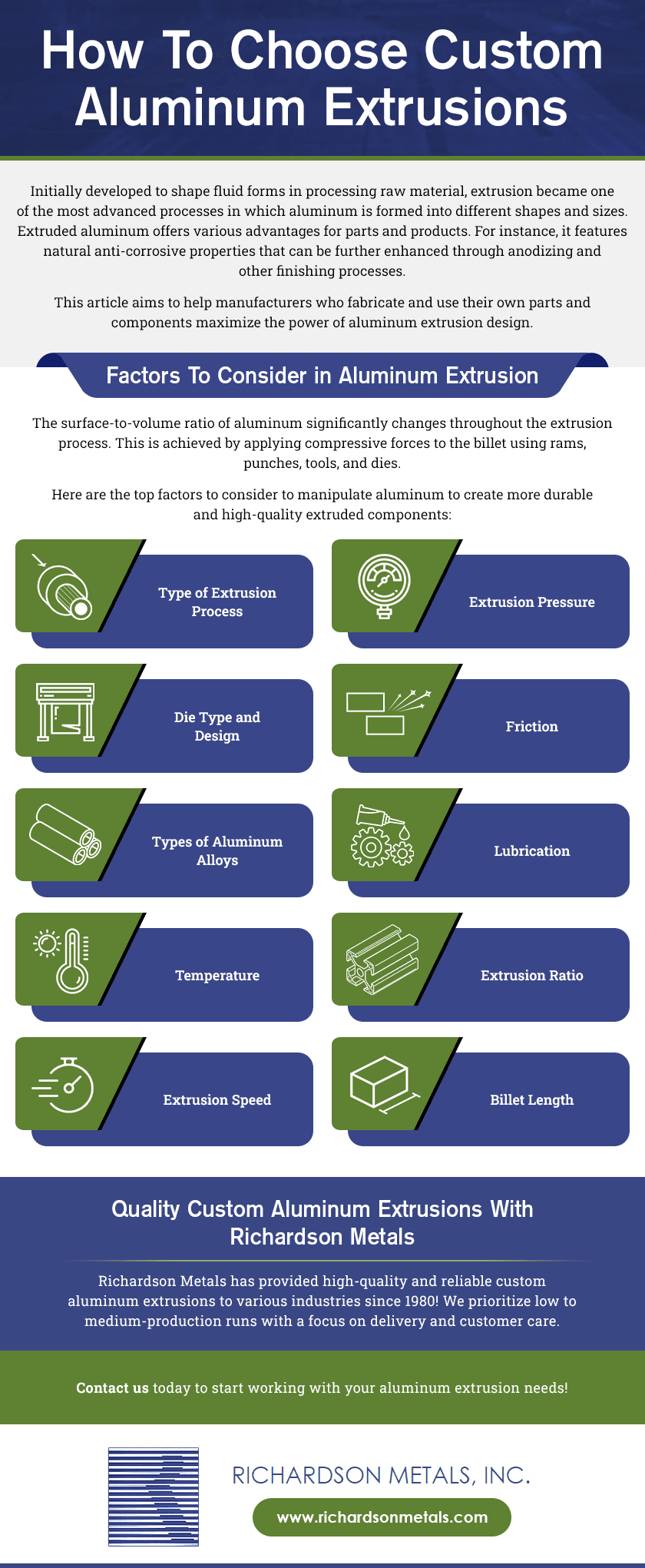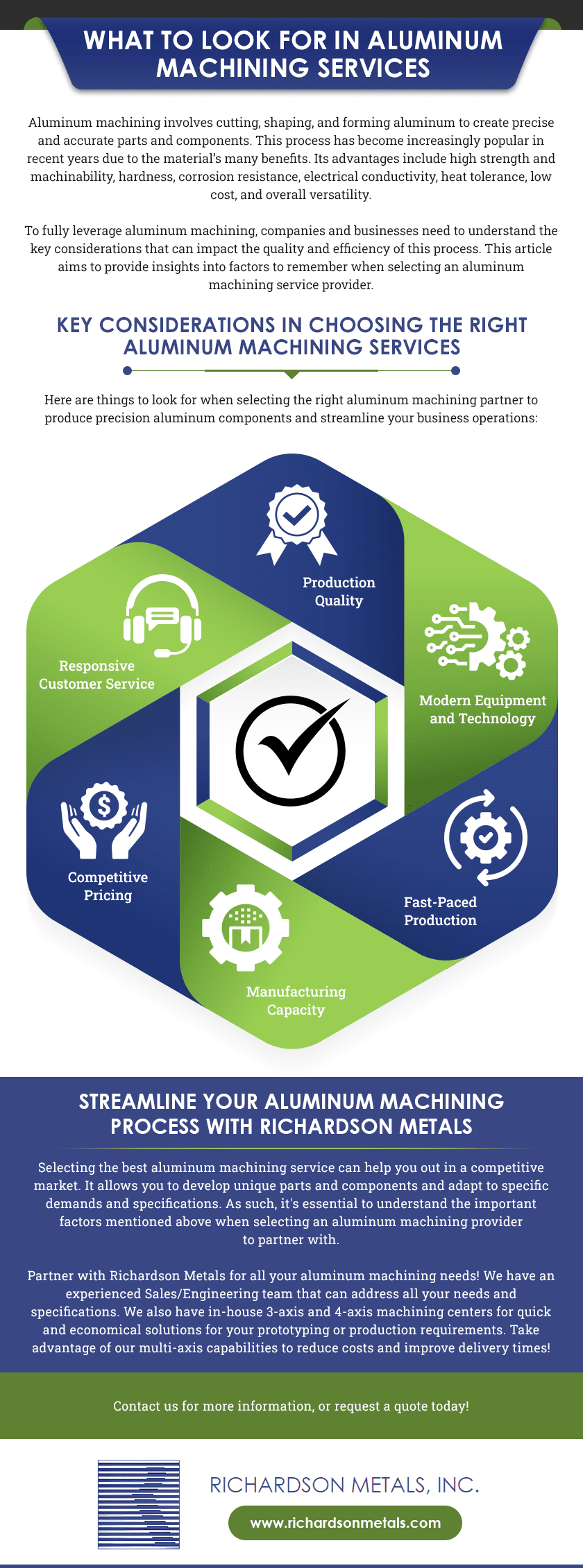How To Choose Custom Aluminum Extrusions
Leave a CommentInitially developed to shape fluid forms in processing raw material, extrusion became one of the most advanced processes in which aluminum is formed into different shapes and sizes. Extruded aluminum offers various advantages for parts and products. For instance, it features natural anti-corrosive properties that can be further enhanced through anodizing and other finishing processes.
This article aims to help manufacturers who fabricate and use their own parts and components maximize the power of aluminum extrusion design.
Factors To Consider in Aluminum Extrusion
The surface-to-volume ratio of aluminum significantly changes throughout the extrusion process. This is achieved by applying compressive forces to the billet using rams, punches, tools, and dies.
Here are the top factors to consider to manipulate aluminum to create more durable and high-quality extruded components:
Type of Extrusion Process
There are two types of extrusion processes: direct and indirect. Direct extrusion is when the ram and the metal flow in the same direction; indirect extrusion is the opposite. A reliable aluminum extrusion provider can easily differentiate which of the two types is advantageous for fabricating a specific component.
Extrusion Pressure
The pressure needed to start metal flowing and reduce friction at the interfaces between the billet, die, and the chamber is exceeded by the extrusion pressure. It varies between 800 MPa and 1200 MPa.
Friction
In custom aluminum extrusion, friction between the billet and die, or chamber and die, is crucial. To manage the metal flow and lower the amount of power needed for compression, friction is removed or minimized.
Die Type and Design
The elements that form the metal are called dies, and their designs dictate the mechanical operation of the metal during extrusion. Dies for extrusion can be solid, semi-hollow, or hollow.
Lubrication
Extruding high-strength aluminum alloys calls for lubrication to help the metal as it is distorted as the die and the billet slides up against the chamber. Lubricants used for the process are a mixture of glass powder, graphite, and oil.
Types of Aluminum Alloys
Different aluminum alloys call for various extrusion settings, as aluminum alloys are categorized into series according to the primary alloying element. For instance, Alloy 6063 and Alloy 6061 are popular material choices for extruding aluminum alloys because they provide a high-quality finish.
Temperature
Extruding aluminum in high temperatures — between 375 °C (705 °F) and 500 °C (932 °F) — is known as “hot extrusion.” High temperatures improve the flow of the metal, resulting in flawless extrudates. However, high-temperature extrusion can be disadvantageous in some applications. Thus, you must work with a manufacturing partner who can advise on the best techniques per project.
Extrusion Ratio
The billet and die opening cross-sectional area ratio defines the extrusion ratio. Larger deformation results from a higher extrusion ratio. Therefore, a higher pressure must be applied to the aluminum material to decrease the ratio.
Extrusion Speed
Extrusion speed is defined as how quickly metal passes through the die. The extrusion speed should be balanced to keep the metal at the proper temperature. For example, high extrusion pressures are needed for faster extrusion speeds, which raise exit temperatures. On the other hand, slower speeds give the temperature plenty of opportunity to flow and disperse.
Billet Length
The length, shape, and extrusion ratio of the extrudate are constrained for a given billet diameter by the billet length. Additionally, the billet length impacts the necessary extrusion pressure, as the needed extrusion pressure increases with billet length.
Quality Custom Aluminum Extrusions With Richardson Metals
Richardson Metals has provided high-quality and reliable custom aluminum extrusions to various industries since 1980! We prioritize low to medium-production runs with a focus on delivery and customer care.
Contact us today to start working with your aluminum extrusion needs!
What To Look For in Aluminum Machining Services
Leave a CommentAluminum machining involves cutting, shaping, and forming aluminum to create precise and accurate parts and components. This process has become increasingly popular in recent years due to the material’s many benefits. Its advantages include high strength and machinability, hardness, corrosion resistance, electrical conductivity, heat tolerance, low cost, and overall versatility.
To fully leverage aluminum machining, companies and businesses need to understand the key considerations that can impact the quality and efficiency of this process. This article aims to provide insights into factors to remember when selecting an aluminum machining service provider.
Key Considerations in Choosing the Right Aluminum Machining Services
Here are things to look for when selecting the right aluminum machining partner to produce precision aluminum components and streamline your business operations:
Production Quality
An aluminum machining provider’s quality of work helps businesses get more durable components and boost their reputation among customers. Some factors to look at include precision, accuracy, and attention to detail. Thus, it’s best to look at examples of the company’s previous work or ask for references to get an idea of their level of expertise and specialization.
Modern Equipment and Technology
A reliable and ideal aluminum machining partner would have cutting-edge technology, software, and programming tools. This will ensure that the work is done quickly and efficiently, with minimal to zero errors.
Fast-Paced Production
Accurate lead time estimates are crucial for effective planning and scheduling. It also allows businesses to allocate resources efficiently and make solid commitments to customers. Look for a company that can set clear expectations and provides fast turnaround times without sacrificing quality.
Manufacturing Capacity
Businesses that can produce or acquire high-quality components faster gain a competitive advantage over overtaking competitors in the market. When looking for an aluminum machining service provider, work with one that can handle both low- and high-volume orders. They must also have sufficient equipment and staffing to take on custom jobs.
Competitive Pricing
Look for a manufacturer that offers affordable prices while maintaining the quality of your desired outcome. However, it’s vital to remember that the cheapest choice is often not the most cost-effective option. Thus, find a partner that can strike a balance between affordability and high-quality services.
Responsive Customer Service
The company you work with should be ready to answer any inquiries and update you on the project’s status. A robust customer service system also ensures that any issues that may arise during production are quickly and efficie.
Streamline Your Aluminum Machining Process With Richardson Metals
Selecting the best aluminum machining service can help you out in a competitive market. It allows you to develop unique parts and components and adapt to specific demands and specifications. As such, it’s essential to understand the important factors mentioned above when selecting an aluminum machining provider to partner with.
Partner with Richardson Metals for all your aluminum machining needs! We have an experienced Sales/Engineering team that can address all your needs and specifications. We also have in-house 3-axis and 4-axis machining centers for quick and economical solutions for your prototyping or production requirements. Take advantage of our multi-axis capabilities to reduce costs and improve delivery times!
Contact us for more information, or request a quote today!


